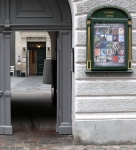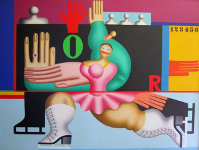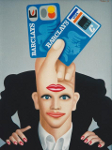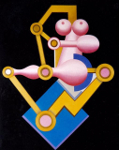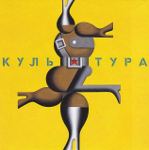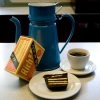| Counterweight Hans Ticha’s critical art before and after the fall of the Wall |
|
CLOSED May 12, 2013 Tiny heads, big hands applauding, swelling bodies and strong colours – in a daring and ironic way Hans Ticha challenges the many faces of power and consumerism. Behind the Wall Art in GDR had a specific function. The controlling regime used culture and art as instruments to further the socialist project. Artists were to contribute to the development of a “workers’ and farmers’ state” and a “new Socialist man” – the leading culture-political ideal being “Socialist realism”. Artists who failed to meet the demands and expectations of those in power were subjected to censorship, deprived of their right of speech and – to the last degree – imprisoned or driven out of the GDR. Hans Ticha, painter and lithographic artist, is one of the central GDR artists that were critical towards the ruling regime. He had to walk on a tightrope to avoid personal infringement when attacking the East German dictatorship in his ironic and ambiguous works – the regime kept a sharp watch on him. Hans Ticha actually had to hide many of his political paintings from the 1980’ies – paintings that can be seen in the exhibition at the Workers’ Museum – behind more innocent works of art in his studio in East Berlin. Otherwise he would have been accused of criminal state defamation. The starting point of Hans Ticha’s works is the citizens’ actual living conditions during the GDR regime, but the motifs are universal: the rhetoric of the rulers, the alienation of the individual and the conformism of society. Hans Ticha (born 1940), originally certified teacher in pedagogics and artistic taste, graduated as a painter from Hochschule für Bildende und Angewandte Kunst in Berlin (1965-70) and then worked as book illustrator, lithographic artist and painter. He set up his studio in Berlin-Prenzlauer Berg and joined the art circle at Kollwitzplatz. During the 1970’ies Hans Ticha was widely acknowledged and received several prizes for his works within applied graphic art and book illustrations and he was counted among leading young illustrators like Ruth Knorr, Klaus Ensikat and Horst Hussel. Yet he was unable to exhibit his political paintings. Goodbye to GDR After the fall of the Wall 1989 and the reunification Hans Ticha moved to Maintal, Frankfurt am Main where he realized that his critical view on the mechanisms and power balances of society was still greatly needed. In his more recent works he focuses on motifs like the unstoppable consumerism, the dominance of the financial sector and the human body as an object. And now he can finally finish and exhibit his political works from the GDR. Over the years Hans Ticha has received a vast number of prizes and distinctions and has exhibited in the GDR, in Germany as well as internationally. The exhibition at the Workers’ Museum covers works from 1969 to 2011 and is his first museum exhibition in Denmark. Central Motives Hans Ticha’s critical art from the GDR mainly centres on the self-staging of those in power and the extensive use of rituals and symbols at for instance military parades and political mass meetings. In Hans Ticha’s artistic idiom man is the central figure. The political followers and oppressed “socialist model citizens” with grotesquely enlarged hands and tiny heads with no facial expressions are merely props in the cheering ceremonies staged by the power elite. People are manipulated and depicted as a homogeneous mass exploited by the regime as illustrated in his many paintings of applauding figures. Another favourite motive is GDR’s pursuit of athletes as symbols of the superiority and capacity of the regime. Swelling, hormone bursting and simplified bodies enthusiastically engaged in football, hockey and hurdle race. In the reunited Germany Hans Ticha focuses on a civilization where man is subjected to the capitalist society’s craving for consumption. With a sense of humour, Hans Ticha now pinpoints the manipulations of the free market and his recent paintings present the idea that whatever we wish for and dream of can be bought – be it experiences, sex or material goods. The Idiom Hans Ticha’s artistic idiom is varied – he moves freely between the realistically figurative and the abstract, and strong clear colours are characteristic. The many swelling and deformed human bodies in his artistic universe are graphically pinpointed and often depicted in dynamic movement. The artistic effects are far from the rooted prejudice of a DDR in shades of orange and brown, and obviously many art critics regard Hans Ticha as the only pop artist from the DDR period. Hans Ticha deliberately uses the aesthetics of the press photography for instance by applying coarse rasters in his paintings and he is inspired by popular culture and the rituals of everyday life. However, he also carries a classical art ballast and his artistic idiom is based on the “isms” of the interwar period – from Dadaism and constructivism to surrealism. Hans Ticha himself mentions the Russian constructivist artists, the Bauhaus painters and the French painter Fernand Léger as his main models and inspiration. The exhibition can be seen from February 9 to May 12, 2013. |




